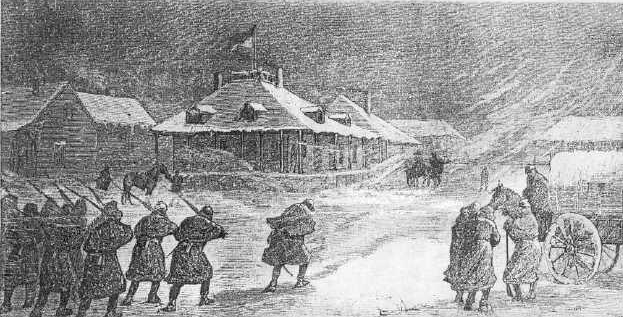
Fort Fetterman, Leslie's Illustrated News, 1876
The above woodcut illustrates Fort Fetterman during General Crook's winter campaign of early 1876 into the
Powder River Country. Compare with photos below. On March 1, 1876, General Crook left Ft. Fetterman with
883 men and a herd of 45 beef cattle. On March 5 the troop ran into a blizzard in which
it was so cold that thermometers did not register and the men while eating had to heat
their forks in the coals of their fires to prevent the tines from freezing to their tongues. Following the Battle of Powder River on March
17, Crook returned to Ft. Fetterman.
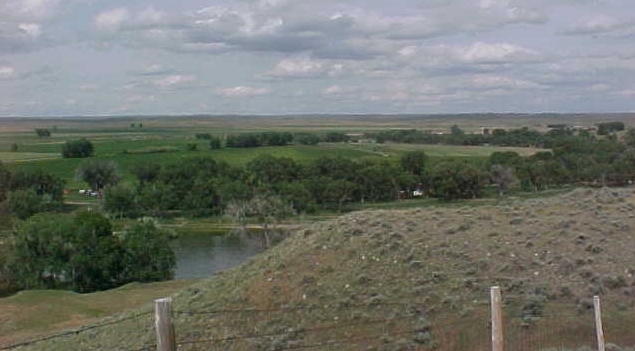
Looking Northeast from Ft. Fetterman, 2001, Photo by Geoff Dobson
Gen. Crook's camp at Ft. Fetterman was located on the field on the far side of the Platte River toward
the center of the above photo. From here on May 29, 1876, he set forth toward the
former site of Ft. Reno with 1,000 cavalry and infantry enlisted men, 50
officers, and 262 Crow and Shoshoni scouts. By June 12 he had reached
Clear Creek near the present site of Buffalo. From there he proceeded up to the confluence of
Big and Little Goose Creeks at present day Sheridan. On June 17 the Company was
surprised by Indians at the Rosebud just north of the Wyoming Line, resulting in
Crook's withdrawal back to the Tongue River. The Battle of the Rosebud is regarded as
an Indian victory and some contend that the result was one of the causes of the loss by
Custer eight days later at the Little Big Horn or Greasy Grass.
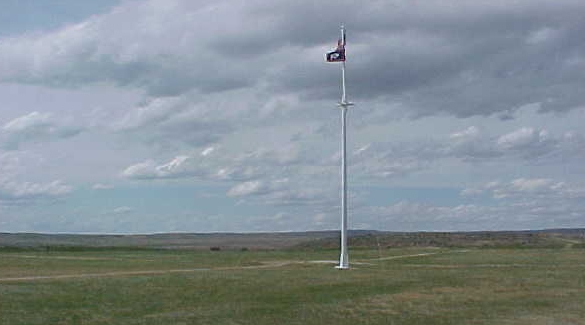
Fort Fetterman, Parade Ground, 2001, photo by Geoff Dobson
Fort Fetterman was established in 1867 and lasted until 1882 when abandoned by the Army.
The adjacent town of Fetterman City continued on for several more years until the Railroad reached
present day Douglas in 1886. Following the abandonment of Forts Reno and
Phil Kearney after the Treaty of Fort Laramie, Ft. Fetterman was the northernmost point on the telegraph line
to Ft. Laramie and the northernmost fort in eastern Wyoming. During its brief existence the fort was always regarded as
hardship duty. One of the early commanders complained about the cold, the isolation, and the lack
of women. The latter complaint was partially resolved with the establishment of a hog ranch on the
north side of the river, the site of which is depicted in the next photo.
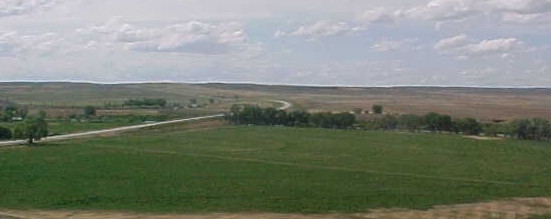
Site of Fort Fetterman Hog Ranch, 2001, photo by Geoff Dobson
The Hog Ranch was located on the north side of the Platte River beyond the trees and to the right of the road in the
above photo. A hog ranch was an establishment which combined the sins of gambling, booze, and
women of the night into one convenient location. Insofar as the troops at
Fort Fetterman were concerned it might not have been so convenient. As can
be seen in the above photo, it was on the opposite side of the river from the Fort. Soldiers
therefore had to swim across in order to enjoy its delights. Calamity Jane in her "autobiography" claims to
have swam the Platte River, not, however, to get to the Hog Ranch. She claimed that during General
Crook's campaign that she was stationed at Ft. Fetterman and had to swim the
river in order to deliver a dispatch to Gen. Crook. After delivery of the dispatch, she
alleges that she was returned to Ft. Fetterman in Crook's ambulance and recuperated for two weeks in the
post hospital. For further discussion of Calamity Jane see Deadwood Stage page.
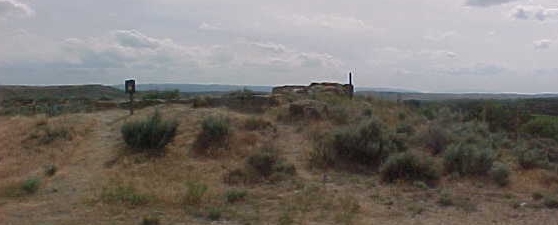
Ruins of Cistern, 2001, photo by Geoff Dobson
In addition to the cold and isolation, another difficulty with Fort Fetterman was lack of water.
Not withstanding that it was located adjacent to the North Platte River, the fort
was high on a bluff and water had to be carried by hand in buckets to the cistern. Eventually, however, as
depicted in the next photo, a pump was installed making life a little easier for enlisted men.
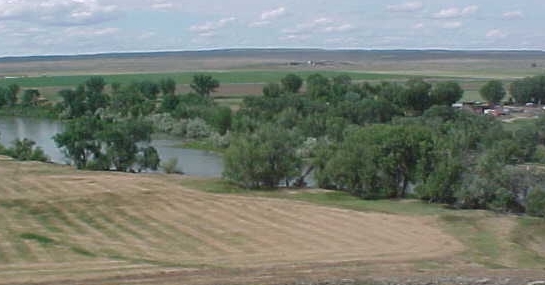
North Platte River, Ft. Fetterman, photo by Geoff Dobson
The pump to serve the fort was located near the clump of trees in the center of the photo.
As indicated above and on the next page, the adjacent town of Fetterman City continued on using some of the
fort's buildings until Doublas was established. One of the building which continued to be used was
the bachelor officers quarters, the site of which is depicted below.
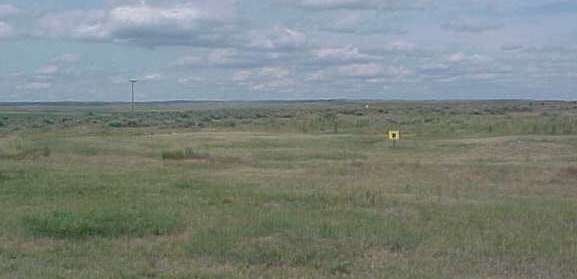
Site of Bachelor Officers Quarters, 2001, photo by Geoff Dobson
After the withdrawal of the military the bachelor officers quarters were used as the Hotel
Fetterman and the site was occupied by civilians. Owen Wister in his 1897 novel Lin McLean
described Fetterman City, referring to it as "Drybone":
"Drybone had known a wholesome adventurous youth, where manly lives and
deaths were plenty. It had been an army post. It had seen horse and foot,
and heard the trumpet. Brave wives had kept house for their captains upon
its bluffs. Winter and summer they had made the best of it. When the War
Department ordered the captains to catch Indians, the wives bade them
Godspeed. When the Interior Department ordered the captains to let the
Indians go again, still they made the best of it. You must not waste
Indians. Indians were a source of revenue to so many people in Washington
and elsewhere. But the process of catching Indians, armed with weapons
sold them by friends of the Interior Department, was not entirely
harmless. Therefore there came to be graves in the Drybone graveyard. The
pale weather-washed head-boards told all about it: "Sacred to the memory
of Private So-and-So, killed on the Dry Cheyenne, May 6, 1875." Or it
would be, "Mrs. So-and-So, found scalped on Sage Creek." But even the
financiers at Washington could not wholly preserve the Indian in
Drybone's neighborhood. As the cattle by ten thousands came treading with
the next step of civilization into this huge domain, the soldiers were
taken away. Some of them went West to fight more Indians in Idaho,
Oregon, or Arizona. The battles of the others being done, they went East
in better coffins to sleep where their mothers or their comrades wanted
them. Though wind and rain wrought changes upon the hill, the ready-made
graves and boxes which these soldiers left behind proved heirlooms as
serviceable in their way as were the tenements that the living had
bequeathed to Drybone. Into these empty barracks came to dwell and do
business every joy that made the cow-puncher's holiday, and every hunted
person who was baffling the sheriff. For the sheriff must stop outside
the line of Drybone, as shall presently be made clear.* The captain's
quarters were a saloon now; professional cards were going in the
adjutant's office night and day; and the commissary building made a good
dance-hall and hotel. Instead of guard-mounting, you would see a
horse-race on the parade-ground, and there was no provost-sergeant to
gather up the broken bottles and old boots. Heaps of these choked the
rusty fountain. In the tufts of yellow, ragged grass that dotted the
place plentifully were lodged many aces and queens and ten-spots, which
the Drybone wind had blown wide from the doors out of which they had been
thrown when a new pack was called for inside. Among the grass tufts would
lie visitors who had applied for beds too late at the dance-hall, frankly
sleeping their whiskey off in the morning air."
[*Webmaster's note: Until the federal government relinquishes jurisdiction to the
state or territory, local authorities have no authority within the confines of a
federal reservation.]
Fetterman City
is also noted as being the place where Malcom Campbell captured Colorado's favorite
cannibal, Alferd Packer. Packer, photo below right, was living under the alias of John Swartz,
and was caught because a customer in a saloon recognized his laugh.
Packer survived a severe winter near present day Breckinridge by dining on his
five companions. Upon his sentencing it is the popular legend that the judge told him:
"There were seven Demmycrats in Hinsdale County and you
ate five of them."
In actuality, the legend is untrue and probably finds its origin with a
report by Saquache saloon keeper Larry Dolan.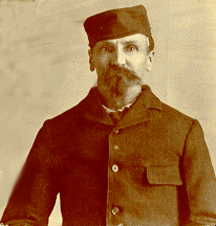 District Judge Melville B. Gerry,
although a Democrat, was a well respected jurist. The sentencing has been reported:
District Judge Melville B. Gerry,
although a Democrat, was a well respected jurist. The sentencing has been reported:
In 1872, you in the company with five companions, passed
through this beautiful mountain valley where stands the town of Lake City.
You and your victims had a weary march, and when the shadows of the
mountains fell upon your little party and the night drew her sable curtain
around you, your unsuspecting victims lay down on the ground and were soon
lost in the sleep of the weary; and then, thus sweetly unconscious of danger
from any quarter, and particularly from you, their trusted companion,
you cruelly and brutally slew them all. To other sickening details of your
crime I will not refer. I sentence you to be hanged by the neck until
you are dead, dead, dead, and may God have mercy on your soul.
Yet another version merely has the judge sentencing Packer, in conventional lanquage,
to be taken by the sheriff to a place in Lake City on a date specified and hanged.
Some debate exists as to Packer's correct first name, Alferd or Alfred. Packer usually signed
his name "A. G. Packer." Military and judicial records use "Alfred." Packer had a tatoo
using "Alferd." The
invitations to the scheduled hanging also used "Alferd." [Webmaster's comment:
Except when one is the guest of honor, how does one respond to an invitation to a
hanging? Is it R.S.V.P? Does one bring a gift or a going away present?]
The hanging was called off
when the conviction was reversed because the offense took place on an Indian
reservation and was, thus, not technically a violation of Colorado law. Packer was
subsequently convicted of manslaughter. Efforts by the Denver Post to have Packer
pardoned by Gov. Charles Thomas were unsuccessful. Governor Thomas later intimated that he
was in possession of correspondence from Packer that was so foul as not to be repeatable.
Even many years after Packer's death, Gov. Richard Lamm in 1979 refused a posthumous
pardon.
Today, as all Colorado Buffs fans are aware, Packer is honored by having the student eatery next to the
campus book store in the basement of the Student Service Center named the Alferd Packer Memorial Grille.
Colorado, however, may not necessarily have a monopoly on such matters. Eugene Ware in his 1911 work,
The Indian War of 1864, repeats a story told by an army scout, Leon
Palladie:
[T]he post commander up at Fort Benton, on the Missouri river,
heard that the Indians were plotting to destroy the frontier and had mapped
out among other things, a campaign against Fort Laramie. That was perhaps
about 1861 or 1862. The post commander of Fort Benton determined to send
a messenger across the country during the winter for the purpose of
notifying the commanding officers at Fort Laramie, because he thought
the latter post could not stand in the dead of winter a heavy siege
from the combined Indian nations. The mountaineer who was selected
to go wanted a companion; a half-breed Indian was sent with him. This
white courier was sent off with a letter which started out by saying:
"I send you Mr. So-and-so, accompanied by a halfbreed, So-and-so, to
convey you the following important information." The letter was presented
to Fort Laramie by the courier to the post commander, and he, after
reading the opening portion of it, said, "Where is your comrade?" and
the courier said, "I eat him." They had floundered through the snow and
the mountains, and the mountaineer had to eat the other man in order to
carry the message through in safety. Leo Palladie would tell this story,
and laugh and shriek every time he told it. It always seemed new and
interesting to him. I never could find anybody who ever heard the name
of the messenger that was sent, and I often used to think Palladie was
telling the story of one of his own personal experiences.
Palladie continued as a scout as late as the 1870's, serving with the 3rd Cavalry in 1872.
Fetterman City today, as indicated in the above photos, consists of a few foundations.
|